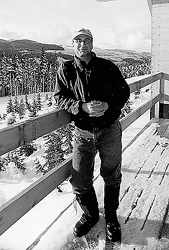The village plan, assembled by TREC International Inc. consultants, has everybody excited at possibilities for the future. Mt.Washington General Manager Peter Gibson is the first to acknowledge
that a similar plan was unveiled with much fanfare — and little progress to show for it — a couple of years ago. This time is different. “It’s not like we’ve done anything new or different … we’ve just put things into place. A year ago the plan really didn’t define the village core,” Gibson says. “It didn’t define us into summer and winter.
“We’re the only alpine all-season, all-used destination resort combining both alpine and coastal recreation experiences in one place in North America,” he said.
“What we’re trying to do is not build a bunch more condos, but build a village core with activities, retail and dining options,” he said.
TREC examined several family alpine destination resorts in North America that had characteristics similar to Mt.Washington. Their report finds that most resorts positioned their village as a hub of activities both on and off the mountain. Within the next 10 years the community at Mt.Washington could consist of vacation homes, residential condos, expanded recreational venues, a variety of restaurants, retail shops and a myriad of other entertainment and educational amenities. TREC advises keeping the resort at a small-scale setting — not another Whistler — to allow people to
congregate and get to know one’s neighbors.
The core components of the village concept would be condos, a resort hotel, time share units and commercial retail. This village would be developed in the vicinity of the existing Deer Lodge.
Expansion and real estate will go hand in hand with this new plan, Gibson says. The resort has plans to build a new base on the west side, with the new lodge as its major feature. Eventually, there will be more territory for nordic skiing, new intermediate downhill runs and chairlifts.
“When somebody wants to buy a site, that’s when it starts,” he says. The cash infusion from development opportunities will be used for expansion plans. This also ensures that both property and amenities grow at the same rate, and in an orderly fashion.
“It’s a very unique situation we have here,” CEO George Stuart said during a VIP tour of the mountain’s facilities in October. Last winter the resort drew 325,000 skier visits, with another 150,000 estimated for summer visits.
Although Stuart doesn’t suggest Mt.Washington will ever draw the two million visitors that Whistler sees each season, “we want to balance our two seasons.”
An on-site survey done by TREC last February and March showed that almost half of the people interviewed said they were interested in owning real estate at the mountain in the future. Gibson is heartened by the fact that 240 people have expressed definite interest in purchasing real estate on the mountain. The majority (87 per cent) of existing owners are in favor of an expansion in activities and amenities, according to the TREC report. The 13 per cent who were not in favor of any development said they feared the mountain would turn into another Whistler.
The report predicts that new owners would likely be second home investors or second home users (the latter looking for vacation property as opposed to an investment). If everything goes according to plan, the village could increase by more than 400 units by 2011 — with the bulk of expansion happening between 2007 and 2011.
TREC also indicated that the mountain could support a 57-unit hotel as early as 2001, provided an operator and developer could be found. Mt.Washington’s rezoning application was first received by the Comox-Strathcona Regional District on May 7, 1997 and advanced to first and second reading before amendments were requested. The plan then stagnated at second reading until March 27, 2000, when regional board members gave the nod – to a vastly different plan – to proceed to public hearing.
The first part of the public process occurred in April, when a couple of dozen people showed up for an information meeting on the mountain. More open houses in early October, this time in Courtenay and Victoria, have provided resort management with more public input. Director of operations Jay Oddliefson, who is overseeing expansion plans for the mountain, has been making presentations to various government bodies and other organizations in the Comox Valley, to get the word out about the proposed local area plan.
“We want to grow beyond 750 units,” which is what the old land use contract called for, Oddliefson said. Mt.Washington is presently at 550 units, with 3,500 beds. The mountain has agreed to stay at the 750-unit cap until the Local Area Plan is developed, at which time they would want the restrictive covenant removed.
Oddliefson has also put together a comprehensive real estate package for those interested in developing property on the mountain. A public hearing on Mt.Washington’s plans for the future will be held in early February, 2001.#

Director of Operations, Jay Oddliefson is overseeing the expansion plans for the resort.
Did you know …
- That Mt.Washington was the first planned ski area in B.C. Blackcomb was the second.
- That, in its first two or three years of operation, Mt.Washington actually outgrew Blackcomb.
- Since opening 21 years ago, Mt.Washington has recorded over five million skier visits.
- Conde Noste travel magazine voted Vancouver Island the number one non-tropical island destination in the world in 1999.
